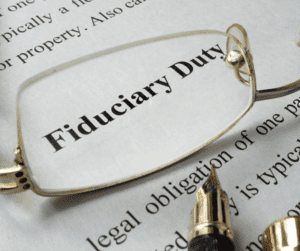
Investing can be an exciting way to grow your wealth and secure your financial future. However, it can also be intimidating, especially if you’re not familiar with the intricacies of the financial industry. That’s where a financial advisor comes in to help guide you through the process, make informed decisions, and ultimately maximize your returns. But not all financial advisors are created equal, and it’s essential to understand the importance of fiduciary responsibility when choosing an advisor.
At its core, fiduciary responsibility means that your advisor is legally and ethically obligated to act in your best interest. This may seem like a given, but unfortunately, not all advisors operate this way. Various fiduciary standards exist, including the “prudent investor” standard, the “sole interest” standard, and the “loyalty” standard, each offering different levels of client protection. It is essential to know which standard your advisor adheres to. The suitability standard, a lower standard of care, requires advisors to recommend “suitable” investments for clients, rather than those in their best interest, while the fiduciary standard offers higher client protection.
Some advisors may prioritize their own interests over their clients’ interests. This can lead to conflicts of interest, biased advice, and ultimately, suboptimal investment decisions. On the other hand, fiduciary advisors must prioritize their client’s interests above their own ensuring transparency, objectivity, and accountability.
The Concept of Fiduciary Duty and Its Beginnings
The concept of fiduciary duty dates back to ancient Rome, where trustees were appointed to manage property on behalf of others. Over time, this concept evolved and became enshrined in law through various statutes and regulations, such as the Investment Advisers Act of 1940 in the United States. Today, fiduciary duty is a cornerstone of the investment industry and is recognized globally as a critical component of financial planning and investing.
Working with a fiduciary advisor offers numerous benefits including increased transparency, reduced conflicts of interest, and greater peace of mind. A fiduciary advisor should provide objective and unbiased advice, recommend investments that align with your goals and risk tolerance, and disclose any potential conflicts of interest. This can help you make informed decisions, avoid costly mistakes, and ultimately, achieve your financial goals.

Fiduciary Responsibility in Retirement and Estate Planning
Fiduciary responsibility is vital in retirement planning, ensuring clients can retire comfortably. Working with a fiduciary advisor guarantees they prioritize clients’ retirement goals. These advisors can help clients develop comprehensive retirement plans, recommend retirement accounts and maximize Social Security benefits. Benefits of working with a fiduciary advisor for retirement planning include personalized advice, guidance, and a higher likelihood of achieving retirement goals. A good advisor should also assist with complex planning issues such as tax and estate planning.
In estate planning, fiduciary responsibility ensures clients’ estates are managed appropriately after they pass away. Fiduciary advisors can help create estate plans reflecting clients’ wishes and distribute assets in a tax-efficient manner. These advisors can develop comprehensive plans accounting for client’s goals, assets, and tax implication, as well as addressing gifting strategies and charitable gifting. Benefits of working with a fiduciary advisor for estate planning include personalized advice, guidance, and a higher likelihood of achieving estate planning goals, as well as assistance with complex planning issues such as minimizing taxes and avoiding probate.
Conclusion
In summary, choosing the right financial advisor is crucial when it comes to investing. Fiduciary responsibility ensures that your advisor is legally and ethically obligated to act in your best interest, providing transparency, objectivity, and accountability. Working with a fiduciary advisor like Ballentine Capital Advisors can help you make informed decisions, avoid costly mistakes, and ultimately achieve your financial goals. So, whether you’re a seasoned investor or just starting, it’s essential to choose wisely and always go with a fiduciary advisor.
Have a great weekend!
Source: Ballentine Capital Advisors
Golf Tip of the Week
6 Driver Setup Basics That Golfers Should *Always* Check

When a golfer is struggling off the tee, it’s usually because they’re failing to do the driver basics well. Their ball position is back, their weight is forward, and they’re aiming all wrong. The result is a low, spinny slice out to the right. The way you set up your body as your teeing up the golf ball is essential to becoming a good driver of the ball. It all comes down to nailing a few basics in your driver setup, which will allow you to hit longer drives, more consistently. — Joe Plecker, Director of Instruction, Landings Club, Savannah, Ga., Golf Digest Best in State Teacher
The Driver Setup Basics
- Find a level lie
- Pick a side of the tee box
- Half ball over crown
- Add side bend
- Check ball position
- Give it a rip
Driver Setup Basic #1: Find a Level Lie
A key to keeping your game consistent is finding a level lie on the tee. Why? Because a tilted lie can affect your ball flight negatively. A ball above your feet will tend to overdraw more; too far below and it’ll have a tendency to drift to the right. Before you tee up your driver, take a few seconds to feel with your feet for the most level lie on the tee box. Once you start looking, you may be surprised how much tilt some tee boxes have.
Driver Setup Basic #2: Pick a Side
When you tee up your driver, the side of the tee box you pick should match your shot shape. You want to hit across the fairway, to give yourself more margin for error. The left side of the tee box would be a better side for a player who moves the ball from right-to-left. The right side is for a player who moves the ball from left-to-right.
Driver Setup Basic #3: Half Ball Over Crown
Pros think about the tee height of their driver a lot. Amateur golfers, not so much. I always tell my students to think about it this way: When you swing through and hit the ball, the bottom of your driver should remain pristine. It shouldn’t come into contact with the ground at all. To do that, you’ll need to hit the ball on an ascending blow, and tee height is essential to that. The best drives are the ones where the bottom of the club hits the top of the tee. To give yourself enough room with the modern-day drivers, that means pegging it so about half the ball is above the crown of the driver.
Driver Setup Basic #4: Add Side Bend
For most amateurs to hit the ball on an ascending blow, it’s best to add some side bend at address, which changes the path of my swing to hit the ball on an ascending blow and transfer the maximum amount of energy into the golf ball. It’s a power position, but notice how when I add that side bend, the clubface isn’t moving around with it. I’m not changing my grip structure; I’m only tilting the center of my upper body away from the target.
Driver Setup Basic #5: Check Ball Position
Ball position is another key checkpoint to creating that ascending blow, and I always look at the center of the lead shoulder being in alignment with the golf ball—never in front — as a really important position. That will allow me enough room to extend my arms and create the most speed into the ball.
Driver Setup Basic #6: Swing Away
Once we match up all these driver setup basics, we’ll be in a good position to swing away freely. It’ll give you your best chance of hitting a great drive. If one of these basics is off when you tee up your driver, you’ll probably see a loss in both distance and direction. But the good news is they’re easy to check. With a little practice they’ll become second nature — and you’ll find more fairways because of it, too.
Tip adapted from golfdigest.comi
Recipe of the Week
Taco Dip

6-8 Servings
Ingredients
- 1 tablespoon vegetable oil
- 1 1/2 pounds of ground beef
- Half a 1.25-ounce packet of taco seasoning mix, or 3 tablespoons homemade taco seasoning
- 2 tablespoons tomato paste
- One 14.5-ounce can of black beans, drained and rinsed
- 2 cups sour cream
- 2 cups shredded sharp Cheddar
- 1 large tomato, chopped
- 2 cups shredded iceberg lettuce
- Sliced black olives and/or pickled jalapenos, optional
- Tortilla chips, for serving
Instructions
- Heat the oil in a large skillet over medium-high heat. Add the beef, and cook, stirring occasionally, until completely browned, 8 to 10 minutes. Pour off the excess grease, add the taco seasoning, and stir until the beef is well coated. Add the tomato paste and stir until it darkens to a dull brick red, about 30 seconds. Add 3/4 cup water, bring to a simmer, and cook until the mixture thickens 2 to 3 minutes. Add the beans and stir just to warm them through. Remove from the heat, and transfer to an 8-inch square baking dish.
- Heat the oil in a large skillet over medium-high heat. Add the beef, and cook, stirring occasionally, until completely browned, 8 to 10 minutes. Pour off the excess grease, add the taco seasoning, and stir until the beef is well coated. Add the tomato paste and stir until it darkens to a dull brick red, about 30 seconds. Add 3/4 cup water, bring to a simmer, and cook until the mixture thickens 2 to 3 minutes. Add the beans and stir just to warm them through. Remove from the heat, and transfer to an 8-inch square baking dish.
Recipe adapted from foodnetwork.comii
Health Tip of the Week
How To Balance Work And Caregiving

You have your job — the one with a paycheck. And then you have your caregiving responsibilities — helping someone who means the world to you.
Work can be rewarding in more ways than one. So can caregiving. But together, it’s a demanding combination. You may feel like you’ve got more on your plate than you can handle on some days.
A lot of people know exactly what that’s like. Experts estimate that six in 10 family caregivers of adults aged 50 and over also work a full-time or part-time job. And about half of the workforce expects to be providing care for an elder in the next 5 years.
You may be managing your loved one’s bills, doctor’s appointments, meals, and services, and possibly also providing hands-on care with daily tasks like getting dressed, eating, and bathing — in addition to your job.
You need a strategy. These ideas may help you care for your loved one while keeping up your career.
How to Manage the Day-to-Day
Get organized. You likely have a lot on your to-do list, so now isn’t the time to try to keep track of everything in your head. Create a family calendar so everyone knows what’s happening and use it to track activities and doctor’s appointments. If possible, ask siblings to help, and make a schedule that includes everyone.
Visit your local agency on aging. They can often point you toward community resources that can help you now or may help you later. Find your area agency at n4a.org, including the National Association of Area Agencies on Aging.
Read your employee handbook. Your company may have policies on caregivers, flexible work options, and family leave that apply to you. You may also have access to an employee assistance program, which can be a helpful resource.
Keep work separate. As much as possible, try to take care of caregiving duties in your personal hours, rather than during work hours. Schedule calls and doctor’s appointments during your lunch hour and do your research on conditions after you’ve gone home for the day.
Have a backup plan. There may be a time when you must leave work in a hurry. Make sure you have a co-worker or two who can step into your role if needed.
How to Talk to Your Manager or HR
Have the conversation. If you’re caring for a loved one, it’s a significant part of your life, and your boss should probably have some idea. Making it known that you have an important commitment — but that you’re making every effort to continue to put in 100% at work — makes you look thoughtful and devoted to your job.
Ask about flexible work policies. You may be able to make your life easier — while still getting your job done — by taking advantage of a flexible work schedule that your company already offers to employees. Or if not, you can discuss whether a flexible schedule might be possible for you. In one study, most caregivers — 68% — say they had to make work accommodations because of the situation, from changing work hours to taking time off.
A flexible schedule might also mean working remotely a few days a week. It’s a good idea to think about how your boss will feel about the changes you’re suggesting — and come up with a plan that meets as many of your needs — and the company’s — as possible.
Schedule a meeting. This isn’t something you should bring up over coffee in the breakroom. If you anticipate that you might need some time away or an adjustment to your schedule — or you simply want to let your boss or HR know that a situation is unfolding — set up a formal time to talk. You’ll both be more focused.
Make it clear that work is still a priority. If you’re changing things at work, make sure your boss knows you have a plan for getting your work done. If you’re leaving early but will be back at your computer at 9 p.m., let them know. It’s easier for your boss to be supportive if you’re still a productive member of the team.
Don’t wait for an emergency to bring it up. If you can, have this discussion with your higher-up earlier rather than later. If you need to change your schedule or start telecommuting, it may take time to make the transition.
How FMLA Fits In
It may happen that you must use the Family Medical Leave Act, or FMLA, to take some time off work to handle your loved one’s care. The FMLA allows you to take up to 12 weeks off every year, without pay but with job security. Here’s what you should understand about the law:
You must meet certain requirements. In general, you must work for a company with at least 50 employees, a government agency, or an elementary or secondary school to be covered, although state laws may cover you at a smaller employer, so do your research. You must have worked there for at least 12 months, and for at least 1,250 hours in the 12 months prior to taking time off. And you must work where your employer has at least 50 employees within 75 miles. (There are special requirements for airline flight crew employees.)
You might have to use your vacation first. Your employer may require that you use any accrued paid leave you must cover some or all any FMLA leave you take. Or you might choose to do this since your employer isn’t required to pay you during FMLA leave. Check on the details of your company’s policies.
You can keep your health benefits. If your employer is covered, they must maintain your group health insurance coverage while you’re on FMLA time off. But you may have to arrange to pay your share of health insurance premiums.
You don’t have to take your leave all at once. Depending on why you’re taking leave, you may be able to take the 12 weeks in smaller chunks or work a reduced schedule. But if you’re working a shorter or intermittent schedule, your employer can temporarily place you in an alternative job with equal pay and benefits that better accommodates you.
Tip adapted from webmd.comiii
Copyright (C) 2021. Ballentine Capital Advisors. All rights reserved.
Our mailing address is:
Ballentine Capital Advisors
15 Halton Green Way
Greenville, SC 29607
unsubscribe from this list update subscription preferences
Disclosure:
Ballentine Capital Advisors is a registered investment adviser. The advisory services of Ballentine Capital Advisors are not made available in any jurisdiction in which Ballentine Capital Advisors is not registered or is otherwise exempt from registration.
Please review Ballentine Capital Advisors Disclosure Brochure for a complete explanation of fees. Investing involves risks. Investments are not guaranteed and may lose value.
This material is prepared by Ballentine Capital Advisors for informational purposes only. It is not intended to serve as a substitute for personalized investment advice or as a recommendation or solicitation or any particular security, strategy, or investment product.
No representation is being made that any account will or is likely to achieve future profits or losses similar to those shown. You should not assume that investment decisions we make in the future will be profitable or equal the investment performance of the past. Past performance does not indicate future results.
Advisory services through Ballentine Capital Advisors, Inc.
i https://www.golfdigest.com/story/how-to-tee-up-a-driver-golf
ii https://www.foodnetwork.com/recipes/food-network-kitchen/taco-dip-3364332
iii https://www.webmd.com/healthy-aging/caregiver-balance-work

